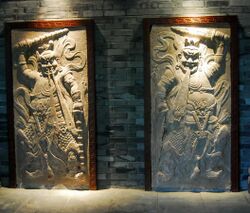Religion:Heng and Ha

Heng and Ha (traditional Chinese: 哼哈二將; simplified Chinese: 哼哈二将; pinyin: Hēng-Hā èr jiàng) are two generals of the Shang dynasty in Chinese mythology, featured within the 16th-century Chinese fantasy novel Investiture of the Gods.[1] These two fictional characters were created by the author of Investiture of the Gods based upon the vajra warriors,[2][3] two guards of Buddhist temples in East Asia,[4] and have become their common names in Chinese.[2]
Novel
In the Investiture of the Gods, the Heng (哼) or Hengjiang (哼将; 'General Heng') is named Zheng Lun (郑伦; 鄭倫) and the Ha (哈) or Hajiang (哈将; 'General Ha') is named Chen Qi (陈奇; 陳奇), both are officials of guarding the grain in the Shang dynasty. Finally, Jiang Ziya canonized and added them to Feng Shen Bang's list (封神榜).[1]
Buddhism
In Chinese Buddhism, Heng and Ha are the common names of the jingang lishi,[2] two guards of Buddhist temples. They are usually placed on both sides of the Shanmen. They hold vajras (short metal weapon that has the symbolic nature of a diamond), namely "Narayana" (Buddha's warrior attendant) or "Yaksha Deity" (夜叉神) or "Zhi Jin Gang" (执金刚; 執金剛) in Chinese. The Vajra originally refers to the short metal weapon of king of all heavenly deities Indra in Indian Buddhist deities and symbolizes solidness and sharpness in Buddhism. Narayana is a Dharmapala who protects Buddhism with his Vajra in his hand.[4]
Originally, there was only one Narayana in Buddhism, after the introduction of Buddhism from India to China it had a profound influence on Chinese traditional culture and folk customs. In order to meet Chinese custom of being in pairs, Chinese people cast two Narayana to safeguard the Shanmen of Buddhist temples. They are wearing crowns, ethereal clothes with their upper bodies exposed, with well-developed muscles and short skirts. They have widely open eyes and protruding noses, holding Vajras in their hands, and glaring the ground awesomely and angrily. The right one, has its mouth open to pronounce the sound "a", while the other has it closed to utter the sound "heng". The symbolism is the same already seen. The generic name for statues with an open mouth is Ha (哈; "a" shape), that for those with a closed mouth Heng (哼; "heng" shape). The two sounds are the start and end sounds in Sanskrit, symbolizing the basis of sounds and bearing the profound theory of Dharma.[4] It is encountered throughout East Asia, including in Japan and Korea. In Japan, Heng and Ha are called A-un.
Gallery
See also
References
- ↑ 1.0 1.1 Xu Zhonglin & Lu Xinxing (2005), p. 709–718.
- ↑ 2.0 2.1 2.2 "哼哈二将不同之处" (in zh-hans). 29 April 2020. https://www.hzcmc.com/topic/hhej/49335.html.
- ↑ "與畫中『哼哈二將』四眼相顧,驚喜就在其中!" (in zh-hant). 6 September 2020. http://www.fgsbmc.org.tw/news_latestnews_c.aspx?News_Id=202009003.
- ↑ 4.0 4.1 4.2 Zi Yan (2012), p. 25–26.
Bibliography
- Zi Yan (2012-08-01). Famous Temples in China. Beijing: Time Publishing and Media Co., Ltd.. ISBN 978-7-5461-3146-7.
- Xu Zhonglin; Lu Xinxing (2005) (in zh). Shanghai: Shanghai Classics Publishing House. ISBN 7-5325-3927-X.
Further reading
- Zhang Yuhuan (2012) (in zh). Beijing: Contemporary China Publishing House. ISBN 978-7-5154-0118-8.
- Wang Guixiang (2016-06-17) (in zh). Beijing: Tsinghua University Press. ISBN 9787302427056.
 |





